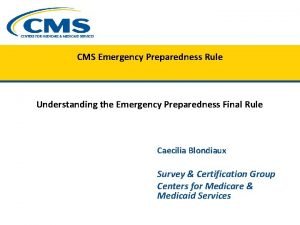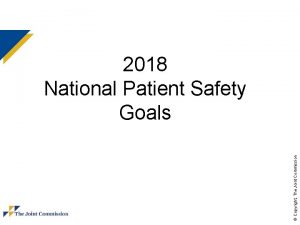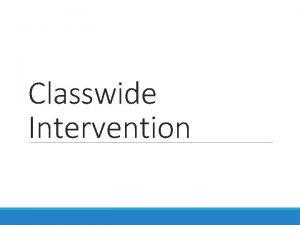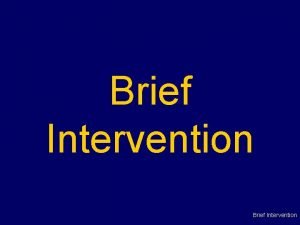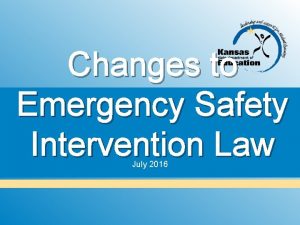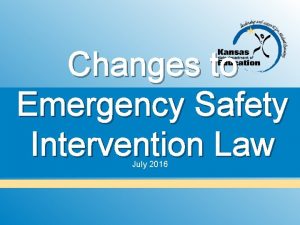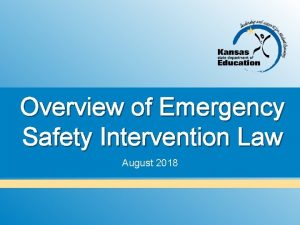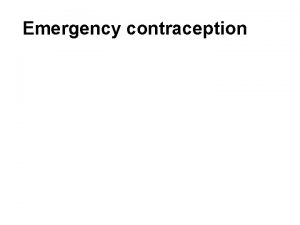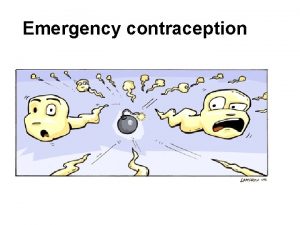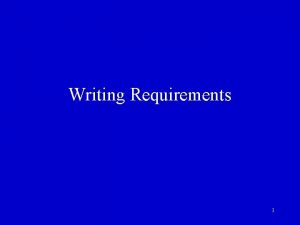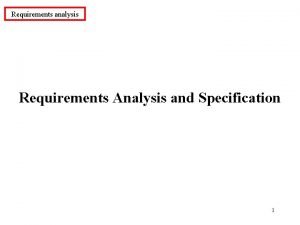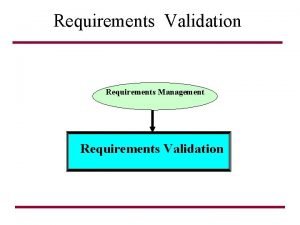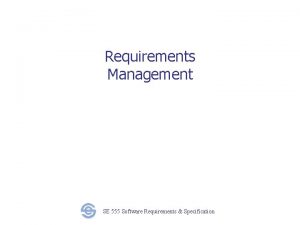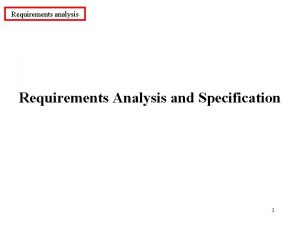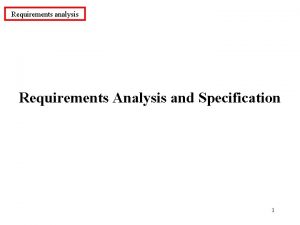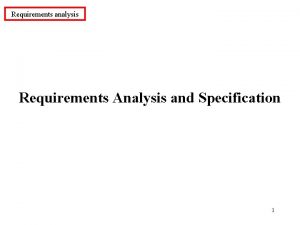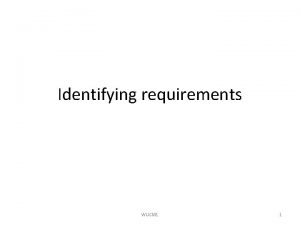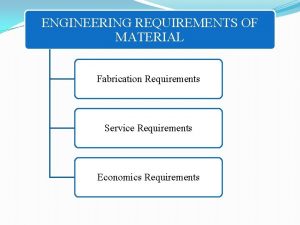Emergency Safety Intervention Requirements July 2018 Emergency Safety



































- Slides: 35

Emergency Safety Intervention: Requirements July 2018

Emergency Safety Intervention Law § In April 2013 the Kansas State Board of Education (State Board) passed regulations on the use of emergency safety interventions § In June 2015, statutes were enacted regarding the use of seclusion and restraint in schools. These statutes created an Emergency Safety Intervention Task Force to study the use of emergency safety interventions and make recommendations. § Amended versions of the statutes and regulations are still in effect and must be followed by school and district staff

Keeping the Terms Straight § Emergency Safety Intervention Law: Requirements relating to the use of emergency safety interventions, includes both statutes and regulations. § Statutes: Passed by the legislature and signed by the governor. § The Freedom from Unsafe Restraint and Seclusion Act: The name of the statutes concerning the use of emergency safety interventions, originally enacted in 2015 and amended in 2016. § Regulations: Requirements adopted by the Kansas State Board of Education that have the full force and effect of law. Regulations were originally adopted in 2013, amended in 2016, and will be amended in the future. § Regulatory requirements: Referring to the requirements relating to the use of emergency safety interventions, includes both statutes and regulations. § Standards: The emergency safety intervention statutes and regulations provide a uniform standard of when emergency safety interventions may be used. School districts are required to draft district policies that conform to the uniform standard in the emergency safety intervention statutes and regulations.

Emergency Safety Intervention Requirements Understanding the requirements at a glance § Key definitions § When an emergency safety intervention may be used § The requirement of a known medical condition that could put the student in mental or physical danger as a result of the emergency safety intervention § § § Notifying parents of an emergency safety intervention incident Law enforcement exemption Meeting with parent to discuss an emergency safety intervention incident(s) District policies and school personnel training Local dispute resolution and State Board administrative review Reporting emergency safety intervention data to the Kansas State Department of Education (KSDE)

Definitions § Emergency Safety Intervention - The use of seclusion or physical restraint § Incident - Each occurrence of the use of an emergency safety intervention § Physical Restraint § Bodily force used to substantially limit a student’s movement, except that consensual, solicited, or unintentional contact and contact to provide comfort, assistance or instruction shall not be deemed to be physical restraint § Physical escort is not physical restraint. This is the temporary touching or holding the hand, wrist, arm, shoulder or back of a student who is acting out for the purpose of inducing the student to walk to a safe location.

Definitions § Seclusion § The placement of a student in a location where all of the following conditions are met: § The student is placed in an enclosed area by school personnel § The student is purposefully isolated from adults and peers § The student is prevented from leaving or the student reasonably believes that such student will be prevented from leaving the enclosed area § Time-out is not seclusion. This is a behavioral intervention in which a student is temporarily removed from a learning activity without being secluded.

Definitions § Parent 1. 2. 3. 4. 5. 6. 7. a natural parent an adoptive parent a person acting as a parent as defined in K. S. A. 72 -3122(d)(2) a legal guardian an education advocate for a student with an exceptionality a foster parent unless the student is a child with an exceptionality a student who has reached the age of majority or is an emancipated minor § School – Any learning environment, including any non-profit institutional day or residential school or accredited nonpublic school, that receives public funding or which is subject to the regulatory authority of the state board of education

When May Emergency Safety Intervention Be Used? § Emergency safety interventions shall only be used when the student presents a reasonable and immediate danger of physical harm to self or others with the present ability to effect such physical harm. § The use of emergency safety intervention must stop as soon as the immediate danger of physical harm ends. § Violent action that is destructive of property and presents a reasonable and immediate danger of physical harm to such student or others with the present ability to effect such physical harm may necessitate the use of an emergency safety intervention.

Requirements for the Use of Seclusion § When a student is placed in seclusion, a staff member must be able to see and hear the student at all times. § All seclusion rooms that have a locking door must be designed to ensure that the lock automatically disengages when the staff member watching the student walks away or in cases of emergency, such as fire or severe weather. § A seclusion room must be a safe place with proportional and similar characteristics as other rooms where students frequent. § If a school uses a seclusion room, it must be free of any condition that could be a danger to the student, and shall be well-ventilated and sufficiently lighted.

Prohibited Types of Restraint § Face-down (prone) physical restraint § Face-up (supine) physical restraint § Physical restraint that obstructs the student’s airway § Physical restraint that impacts a student’s primary mode of communication § Chemical restraint, except as prescribed by an appropriately licensed person for treatment of a medical or psychiatric condition § Mechanical restraint, except: § Protective or stabilizing devices required by law or used in accordance with an order from an appropriately licensed person; § Any device used by law enforcement officers to carry out law enforcement duties; or § Seatbelts and other safety equipment used to secure students during transportation.

Written Statement from Medical Provider § An emergency safety intervention may not be used with a student if the student is known to have a medical condition that could put the student in mental or physical danger as a result of the emergency safety intervention. § The existence of such medical condition must be indicated in a written statement from the student’s licensed health care provider, a copy of which is provided to the school and placed in the student’s file. § The written statement must include an explanation of the student’s diagnosis, a list of any reasons why an emergency safety intervention would put the student in mental or physical danger, and any suggested alternatives to the use of emergency safety interventions. § An emergency safety intervention may still be used if not using an emergency safety intervention would result in significant physical harm to the student or others. § For example, a student with written documentation that the use of an emergency safety intervention would cause mental or physical danger who attempts to run out into a busy street may be restrained for safety.

Notifying Parents of Emergency Safety Intervention Incidents § Parents must be notified on the same day as the incident § The same day notification requirement is satisfied if the school attempts to contact the parent using at least two methods of contact. § A parent may designate a preferred method of contact to receive the same-day notification. § A parent may agree, in writing, to receive only one same-day notification for multiple incidents occurring on the same day.

Notifying Parents of Emergency Safety Intervention Incidents § Written documentation of an emergency safety intervention incident must be completed and provided to the parent no later than the school day following the incident. This must include: § § (A) The events leading up to the incident; (B) student behaviors necessitating the emergency safety intervention; (C) steps taken to transition the student back into the educational setting; (D) the date and time the incident occurred, the type of emergency safety intervention used, the duration of the emergency safety intervention, and the school personnel who used or supervised the emergency safety intervention; § (E) space or an additional form for parents to provide feedback or comments to the school regarding the incident; § (F) a statement that invites and strongly encourages parents to schedule a meeting to discuss the incident and how to prevent future use of emergency safety interventions; and § (G) email and phone contact information for the parent to schedule an emergency safety intervention meeting. § KSDE interprets “written” to mean printed or electronic § Schools may group incidents together when documenting the items in (A), (B), and (C) if the triggering issue necessitating the emergency safety interventions is the same.

Notifying Parents of Emergency Safety Intervention Incidents § Upon the first incident in a school year, parents must be provided the following information in printed form, or upon parent’s written request, by email: § A copy of the standards of when emergency safety interventions can be used § A flyer on the parent’s rights under emergency safety intervention law § Information on the parent’s right to file a complaint with their local board and their right to request administrative review by the State Board § Information that will assist the parent in navigating the complaint process, including contact information for Families Together and the Disability Rights Center of Kansas § For subsequent incidents, schools must provide this information to parents with a full and direct website with the information.

Notifying Parents of Emergency Safety Intervention Incidents § Parent notification if the school is aware that a law enforcement officer or school resource officer used seclusion, physical restraint, or mechanical restraint on a student § The school must notify the parent the same day using the parent’s preferred method of contact for emergency events. § The school is not required to provide the documentation of the incident or the information to the parent specified in slides 15 and 16. § The school is not required to report these incidents to KSDE. § Mechanical restraint includes the use of handcuffs.

Law Enforcement Exemption § Campus police officers and school resource officers are exempt from the requirements of emergency safety intervention statutes and regulations when engaged in an activity that has a legitimate law enforcement purpose. § School security officers are not exempt from the requirements of emergency safety intervention statutes and regulations. § Relevant Definitions § Campus police officer: A school security officer designated by the board of education of any school district pursuant to K. S. A. 72 -8222 § School resource officer: A law enforcement officer or police officer employed by a local law enforcement agency who is assigned to a district through an agreement between the local law enforcement agency and the district. § School security officer: A person who is employed by a board of education of any school district for the purpose of aiding and supplementing state and local law enforcement agencies in which the school district is located, but is not a law enforcement officer or police officer.

Parent Meeting Requirements § The written documentation of any emergency safety intervention incident must contain a statement that invites and strongly encourages parents to schedule a meeting to discuss the incident and how to prevent future use of emergency safety interventions; and email and phone information for the parent to contact the school to schedule the emergency safety intervention meeting. § After each emergency safety intervention incident, a parent may request a meeting with the school to discuss and debrief the incident. A parent may request such meeting verbally, in writing, or by electronic means. The focus of any meeting convened is to discuss proactive ways to prevent the need for emergency safety interventions and to reduce incidents in the future.

Parent Meeting Requirements § If a parent requests a meeting to discuss an emergency safety intervention incident, the meeting must be called within 10 school days. § Nothing prevents a school from grouping incidents into one meeting for discussion, as long as the timeline in the previous sentence is met. § The time for calling this meeting shall be extended beyond the 10 school day limit if the parent is unable to attend within that time period. § The parent will determine whether the student shall be invited to the meeting

Parent Meeting Requirements § If the student has an IEP or a 504 plan: § IEP team or 504 plan team meets to discuss the incident § When an IEP team meets, all IEP notice and meeting requirements must be followed. § The team will consider the need to conduct a functional behavioral analysis, develop a behavior intervention plan (BIP), or amend either if already in existence. § If the student has a 504 plan, the team must discuss and consider the need for a special education evaluation. § If the student does not have an IEP or a 504 plan: § Meeting is between the parent, school administrator, teacher, school employee involved in the incident, and other school employees that the school administrator deems appropriate. § The group will discuss the incident, consider the need for a functional behavioral analysis or BIP, and consider the appropriateness of a referral for a special education evaluation.

Parent Meeting Requirements § For students who have an IEP and are placed in a private school by a parent, a meeting requested by the parent must include the parent and the private school. They will discuss the incident and consider whether the parent should request an IEP team meeting. § If the parent requests an IEP team meeting, the private school must help facilitate such meeting.

District Policies § Each district must update its emergency safety intervention policy to be consistent with the requirements of the statutes and regulations. § The district policy must be accessible on each school’s website. § The district policy must be included in each school’s code of conduct, school safety plan, or student handbook. § The district policy must include a schedule for when and how parents are provided with notice of the district’s emergency safety intervention policy.

School Personnel Training District policies must include school personnel training for all staff in the legal requirements of emergency safety intervention law and must address prevention techniques, de-escalation techniques, and positive behavioral intervention strategies. § Training must be designed to meet the needs of personnel as appropriate to their duties and potential need to use an emergency safety intervention. § If the needs of certain district staff require training on the use of emergency safety intervention such training must be consistent with nationally recognized training programs. § Schools must maintain documentation on training provided and lists of participants.

Data Collection and Review of All Instances of Emergency Safety Intervention § District policy must establish a system by which documentation of each use of emergency safety intervention, for all students for which the district is responsible, is collected and maintained. § District policy must establish a procedure by which each school will periodically review the use of emergency safety interventions for all students for which each school is responsible. § Information maintained by each school on the use of emergency safety intervention must be compiled and submitted, at least biannually, to the district superintendent or superintendent’s designee.

Local Dispute Resolution Emergency safety intervention incident occurs; parent notified Parents receive documentation and feel emergency safety intervention was used appropriately. Parents may choose to first speak with the building administrator to try to resolve the issue informally. If this is effective, the building administrator should provide written documentation of the issues to the superintendent. Upon receiving the local board’s written decision, parents may determine the findings are sufficient and consider the dispute resolved. Parents believe the use of emergency safety intervention did not follow the district’s policy, emergency safety intervention regulations, or statutes. Parents file a written complaint with local board of education within 30 days of being informed of the use of emergency safety intervention. Upon receiving a complaint, the local board will designate an individual to oversee an investigation, maintaining confidentiality. The local board will mail written findings of fact, a final decision, and any corrective action required by the school, to the parent and KSDE within 30 days of receiving the complaint. Upon receiving the local board’s written decision, parents may determine that their concern was not resolved. Parents may proceed to the State Board’s administrative review process. If the local board does not issue a written decision, the parent may proceed to the State Board’s administrative review process.

State Board’s Administrative Review Process Parent filed a complaint with the local board and is not satisfied with the final decision about the use of emergency safety intervention. Parent may file a request for administrative review with the State Board. Parent must do this within 30 days of the local board’s final decision or, if the local board failed to issue a decision, within 60 days of filing a complaint with their local board. State Board will designate a Hearing Officer to conduct a review of the local board’s final decision. The Hearing Officer may initiate a separate investigation. Investigation results will be provided to the parents, school administrators, district superintendent, local board, and State Board within 60 days of the commissioner’s receipt of the request for administrative review.

Reporting of Emergency Safety Intervention Incidents to KSDE Reports to KSDE must be submitted at the student level and include: § KIDS ID number, from this KSDE will pull: Report § Student race/ethnicity s are e ntered the Ka § Student gender in nsas In t egrate § Student age Accoun d tability § Student eligibility for free and reduced lunch (KIAS) applica System tion. § Whether the student had an IEP at the time of the incident § Whether the student had a 504 plan at the time of the incident § Whether the student had a BIP at the time of the incident § Date of incident § Type of incident (seclusion or physical restraint) § Duration of incident

Where Do I Go For Resources? www. ksdetasn. org § Emergency safety intervention law § Flyer or bookmark for staff with requirements § Sample letter to send to a parent after an www. ksde. org/Default. aspx? tabid=524 § Informational packet to distribute to parents § Information on reporting emergency safety § Parent designation of preferred method of § A form that parents may use to request § Sample incident documentation form for staff § Documentation of medical condition form § Power. Point of 2016 changes to statutes and § Emergency safety intervention data analysis § Updates are sent out regularly on many incident after an incident contact for emergency safety intervention incident and same-day notification form regulations § Power. Point for staff training on de-escalation intervention data to KSDE administrative review from the Kansas State Board of Education KSDE listservs (special education directors’, superintendents’, principals’, and Special Education and Title Services)

A Focus on Prevention § KSDE does not promote the use of emergency safety intervention with any student. § KSDE recommends a focus on prevention because there are REAL DANGERS when using emergency safety intervention. § Emergency safety interventions are not part of a tiered intervention plan – they are ONLY to be used in an EMERGENCY. § Emergency safety interventions are reactive strategies and do not decrease the likelihood of a behavior from occurring.

A Focus on Prevention § Focus on using proactive strategies to support students, including positive behavior interventions and supports. § De-escalation is helpful to begin to identify acting out behavior early and use proactive strategies to decrease the use of seclusion and restraint.

A Focus on Prevention § Emergency safety interventions should not be a planned intervention for a specific student under foreseeable circumstances. § Behavior intervention plans should focus on the results of functional behavior assessments and teaching replacement behavior. § If you are planning for it, it means you can see it coming. If you can see it coming, every effort should be made for prevention.

Take Away Point: If you use an Emergency Safety Intervention, you MUST 1. 2. 3. 4. Document it. Notify parents. Learn from it. Seek training on how to implement tiers of prevention and intervention.

District Forms and Policies Personalize forms and policies to include: §Incident documentation form §Parent notification packet §Copy of emergency safety intervention law §District link where the above are accessible

District Contact Information For more information: §[Personalize this slide to include district ESI contact individual(s) here]

KSDE Contact Information §For more information: Laura Jurgensen at ljurgensen@ksde. org or 785 -296 -5522

Laura Jurgensen, Assistant Director Kansas State Department of Education 900 SW Jackson St. Suite 620 785 -296 -5522 ljurgensen@ksde. org The Kansas State Department of Education does not discriminate on the basis of race, color, national origin, sex, disability, or age in its programs and activities and provides equal access to the Boy Scouts and other designated youth groups. The following person has been designated to handle inquiries regarding the nondiscrimination policies: KSDE General Counsel, Office of General Counsel, KSDE, Landon State Office Building, 900 S. W. Jackson, Suite 102, Topeka, KS 66612, (785) 296 -3204
 Que letra continua m v t m j
Que letra continua m v t m j Iecc 2018 commercial
Iecc 2018 commercial Cms emergency preparedness requirements by provider type
Cms emergency preparedness requirements by provider type Oscar and alphonse harris burdick
Oscar and alphonse harris burdick Harris burdick
Harris burdick July 1-4 1863
July 1-4 1863 Tender definition
Tender definition Criciúma ec
Criciúma ec 2001 july 15
2001 july 15 2003 july 17
2003 july 17 July 30 2009 nasa
July 30 2009 nasa Sources nso july frenchhowell neill technology...
Sources nso july frenchhowell neill technology... What is the significance of july 4 1776 brainpop
What is the significance of july 4 1776 brainpop Poppies in july aoifes notes
Poppies in july aoifes notes The cuban melodrama
The cuban melodrama Imagery in poppies in july
Imagery in poppies in july Gdje se rodio nikola tesla
Gdje se rodio nikola tesla Ctdssmap payment schedule july 2021
Ctdssmap payment schedule july 2021 Sergei korolev
Sergei korolev 6th july 1988
6th july 1988 Monday 13th july
Monday 13th july On july 18 2001 a train carrying hazardous chemicals
On july 18 2001 a train carrying hazardous chemicals July 4 sermon
July 4 sermon June too soon july stand by
June too soon july stand by July 2 1937 amelia earhart
July 2 1937 amelia earhart June 22 to july 22
June 22 to july 22 July 12 1776
July 12 1776 Sensory language definition
Sensory language definition Super saturday tribal bingo july 4
Super saturday tribal bingo july 4 March april june july august
March april june july august July 14 1789
July 14 1789 Malaga in july
Malaga in july Why are leaf yeasts more plentiful in july
Why are leaf yeasts more plentiful in july July 26 1953
July 26 1953 July 16 1776
July 16 1776 Q2 national patient safety goals
Q2 national patient safety goals


